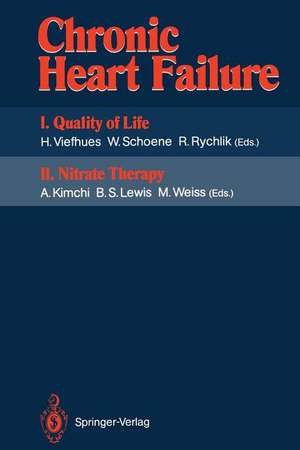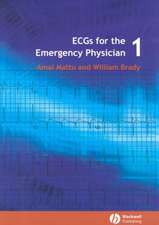Chronic Heart Failure: I. Quality of Life II. Nitrate Therapy
Editat de Herbert Viefhues, Wolfgang Schoene, R. Rychlik, Asher Kimchi, Basil S. Lewis, Marija Weissen Limba Engleză Paperback – 5 dec 2011
Preț: 715.91 lei
Preț vechi: 753.60 lei
-5% Nou
Puncte Express: 1074
Preț estimativ în valută:
136.99€ • 143.69$ • 114.04£
136.99€ • 143.69$ • 114.04£
Carte tipărită la comandă
Livrare economică 01-15 aprilie
Preluare comenzi: 021 569.72.76
Specificații
ISBN-13: 9783642764356
ISBN-10: 3642764355
Pagini: 300
Ilustrații: XI, 282 p.
Dimensiuni: 155 x 235 x 16 mm
Greutate: 0.42 kg
Ediția:Softcover reprint of the original 1st ed. 1991
Editura: Springer Berlin, Heidelberg
Colecția Springer
Locul publicării:Berlin, Heidelberg, Germany
ISBN-10: 3642764355
Pagini: 300
Ilustrații: XI, 282 p.
Dimensiuni: 155 x 235 x 16 mm
Greutate: 0.42 kg
Ediția:Softcover reprint of the original 1st ed. 1991
Editura: Springer Berlin, Heidelberg
Colecția Springer
Locul publicării:Berlin, Heidelberg, Germany
Public țintă
Professional/practitionerDescriere
A. Schneeweiss Although the syndrome of congestive heart failure has been recognized many years ago, the approach for its evaluation and treatment has until recently, been partial and 'fragmentary'. Various aspects of the disease have been treated according to the evaluation tools and therapeutic measures available at each period. This approach resulted in some of the greatest achievements in the management of heart failure but also left many aspects neglected and also resulted in several paradoxes. Examples of the achievements and limitations of the 'fragmentary' ap proach are the use of diuretics and hemodynamic measurements. The devel opment of diuretics has provided us with an important tool for helping pa tients whose predominant problem was edema. The success of diuretics masked the fact that their use may often be hemodynamically unsound and that they may reduce cardiac output. Only many years after their introduction has the use of diuretics found its appropriate place. Hemodynamic monitoring has gone via the same path. The great contribu tion of continuous bedside hemodynamic measurements to understanding heart failure resulted in over-usage by many clinicians, who found themselves treating hemodynamic charts rather than patients. It took almost a decade to realize that hemodynamic improvement, even in the chronic setting, does not necessarily mean symptomatic improvement or an increase in exercise capac ity.
Cuprins
I. Quality of Life.- The Pathophysiological Basis, Clinical Presentation, and Therapy of Chronic Heart Failure.- On the Epidemiology of Heart Failure.- Mortality Versus Quality of Life.- Quality of Life Assessment in Congestive Heart Failure: Points of View from a Cardiologist and a Psychologist.- From Heaven Through the World to the Earth.- Quality of Life: Semantic History, Political and Scientific Terminology, Measurement and Methodology, Medical Research.- Measuring the Quality of Life in Patients with Heart Failure: Basic Principles, Methods, and Use in Clinical Studies.- Quality of Life after Bypass and Valvular Surgery: Results of a Prospective Study.- Guidelines for Improving Prognosis, Stress Tolerance, and Quality of Life in Patients with Heart Failure: Cardiological and Psychological Aspects.- Quality of Life of Infants and Children with Cardiac Disease and Cardiac Failure Both Before and After Cardiac Surgery.- Health Care and Economic Aspects of the Quality of Life of Heart Failure Patients.- The Questionnaire as a Tool for the Empirical Assessment of Quality of Life in Patients with Cardiac Failure.- Quality of Life: A Relevant Endpoint.- Prevention: The Risk Factor Model and Life-Styles Relevant to Health.- II. Nitrate Therapy.- The Role of Nitrates in Congestive Heart Failure.- Chemical Pathways Proposed for the In Vitro Metabolism of Nitrovasodilators and Their Conversion into Vasoactive Species.- Effect of Intravenous Isosorbide Dinitrate Versus Nitroglycerin in Patients with Acute Myocardial Infarction and Elevated Pulmonary Artery Wedge Pressure.- Effects of Isosorbide-5-Mononitrate on Haemodynamics and Exercise Tolerance in Patients with Heart Failure: Comparisons with Digoxin and Placebo.- Improved Left Ventricular Geometry and Function by Prolonged Nitroglycerin Therapy After Acute Myocardial Infarction.- Intravenous Nitroglycerin in Acute Myocardial Infarction.- Effects of Intravenous Nitrates in Acute Myocardial Infarction.- Hemodynamic Effects of a Subchronic Therapy with 120 mg Isosorbide Dinitrate Slow-Release in Coronary Artery Disease and Left Heart Failure.- Isosorbide Dinitrate and Nitroglycerin Oral Spray in Heart Failure.- Nitrates in Heart Failure.













